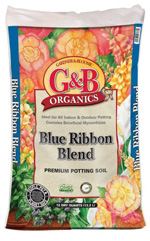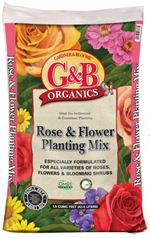|

 An exceptional potting soil for indoor and outdoor containers. 
 Especially formulated for the needs of palm, cactus, citrus & succulents. 
Master Nursery Bumper Crop can be mixed with your native soil as a nutrient-rich amendment to grow vegetables and flowers, or can be used as an organic mulch to help retain water. With added beneficial mycorrhizae, worm castings, bat guano and kelp meal - and no harmful synthetic chemicals  Helps produce more abundant, better tasting and more nutritious vegetables.  Ideal for a variety of in-ground and container planting.  Ideal for all warm-season or cool grasses and new lawns from seed, sod or sprigs |
 |
FEATURED QUOTE : "You know you are a hard-core gardener if you deadhead flowers
in other people's gardens." |
 |
 |
|
The earliest Mother's Day celebrations we know of were ancient Greek spring celebrations in honor of Rhea, the mother of the gods; the ancient Romans also had another holiday, Matronalia, that was dedicated to Juno. But those were in honor of one particular mother. England's "Mothering Sunday," begun in the 1600's, is closer to what we think of as "Mother's Day." Celebrated on the fourth Sunday of Lent, "Mothering Sunday" honored the mothers of England. In 1907, Anna Jarvis started a drive to establish a national Mother's Day. In 1907 she passed out 500 white carnations at her mother's church in West Virginia--one for each mother in the congregation. In 1908, her mother's church held the first Mother's Day service, on May 10th (the second Sunday in May). That same day a special service was held at the Wanamaker Auditorium in Philadelphia, where Anna was from, which could seat no more than a third of the 15,000 people who showed up. By 1909, churches in 46 states, Canada and Mexico were holding Mother's Day services. In the meantime, Ms. Jarvis had quit her job to campaign full time.
She managed to get the World's Sunday School Association to help; they were a big factor in convincing legislators to support the idea.
In 1912, West Virginia was the first state to designate an official Mother's Day. By 1914, the campaign had convinced Congress, Many countries of the world now have their own Mother's Day at different times of the year, but Australia, Belgium, Canada, Denmark, Finland, Italy, Japan, and Turkey join the US in celebrating Mother's Day on the second Sunday of May. Britain still celebrates Mothering Day on the fourth Sunday of Lent--but they now call it Mother's Day. By any name, and at any date, it's a special day to honor a special person. Having trouble thinking of a gift? Why not do something a little different for Mother's Day? Instead of giving her a bouquet of roses, plant her a rose garden! If she already has a rose garden--add to it! If she lives in an apartment, consider a potted rose plant--many roses will do quite well in containers (ask us for suggestions). Why give one bouquet that will soon fade away, when you can give years of pleasure from living roses instead? |

|
So, you've decided to design your own garden! This will prove to be an interesting journey, and if done correctly, the result will provide you and your family with an outdoor space that you can enjoy for years to come.
Some of these questions will be answered based on your area's size.
For instance, even though you like basketball you may or may not be able to fit a
half-court into your area - but perhaps a basketball hoop could be used. |

|
Tomatoes are the favorite vegetable for home growing. Over the past years, commercial growers have produced tomato varieties that valued shelf-life and unblemished prettiness over taste--and the result has been an almost tasteless tomato at your local stores. You can put taste back on top of the list by growing your own. Tips on Choosing Your Tomato Plants:
Planting tips:
Grow your own tomatoes! Your taste buds will thank you! |

|
Tomato hornworms are the larvae of a large sphinx moth that is about the size of a hummingbird. In spring, the moth lays eggs on the underside of tomato (and related plants like pepper and eggplant) leaves. Although the hornworms are quite small when they first emerge, they are big eaters (of leaves) and grow up quickly. Usually, you won't even see this fellow until it is large--about 2 inches long and fat! They are quite distinctive, actually handsome with their diagonal white stripes and horns on the rear. However, due to their camoflage they can be difficult to find (until they've eaten a lot of leaves). Don't be afraid of the hornworms. They look more frightening than they are. They don't bite or sting, just try to look big and ferocious. You can easily handpick to remove from your plants and just throw them away. When they are younger and smaller, use Bt (bacillus thuringiensis) as an effective management technique. Some gardeners have a different approach to the tomato hornworm. While handpicking a hornworm, look to see if you find little white cocoons attached to its back. If you do see this, that cocoon is a pupating braconid wasp, which is a garden-friend predator. Capture the hornworm and keep it (or all of them) in a container, feeding them tomato leaves. You are creating a nursery for the braconid wasps that can then be released into your garden! These wasps will help control the hornworm population. Other natural predators are birds and the larvae of the green lacewing. Plant your gardens to create an inviting habitat for all of these natural predators, and you'll control this voracious eater of your tomato leaves. Luckily, hornworms don't eat the tomato! |
 |
|
Should I fertilize shrubs before or after rain? Answer: Most organic plant foods need moist soil to break down and allow the beneficial microbes in them to proliferate. If the ground is already moist and you know a measurable amount of rain (at least 1/2") is coming, then apply your fertilizer before. If the ground is dry, allow the rain to replenish the soil with moisture and then apply your fertilizer. After you fertilize, make sure to water the fertilizer in so it percolates into the soil. |

 |
Written content © Garden Partners LLC, or respective authors. All Rights Reserved. Privacy Policy. All written content contained in this site is protected by United States copyright law and may not be reproduced, distributed, transmitted, displayed, published, or broadcast without prior written permission of Garden Partners, LLC. You may not alter or remove any trademark, copyright or other notice from copies of the content. |



 which passed a joint resolution. President Woodrow Wilson signed the resolution, establishing an official national Mother's Day on the second Sunday in May.
which passed a joint resolution. President Woodrow Wilson signed the resolution, establishing an official national Mother's Day on the second Sunday in May. 